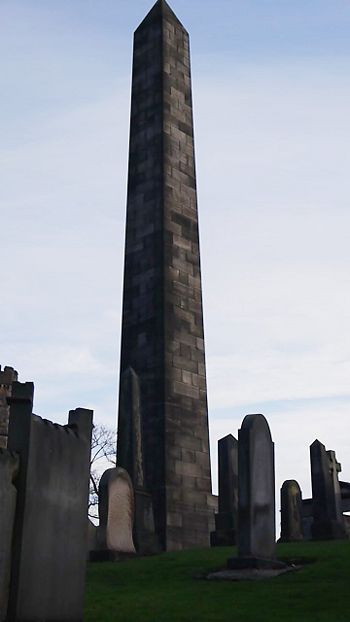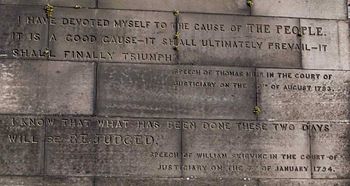Thomas Muir: Difference between revisions
Pat Palmer (talk | contribs) m (Text replacement - "Boston" to "Boston, Massachusetts") |
mNo edit summary |
||
| (2 intermediate revisions by one other user not shown) | |||
| Line 67: | Line 67: | ||
}}</ref> | }}</ref> | ||
Muir landed on [[Vancouver Island]], where he transferred to a Spanish vessel bound for Baja California, hoping to make his way via [[Mexico City]] to [[Havana]] and on to [[Philadelphia]]. | Muir landed on [[Vancouver Island]], where he transferred to a Spanish vessel bound for Baja California, hoping to make his way via [[Mexico City]] to [[Havana]] and on to [[Philadelphia, Pennsylvania|Philadelphia]]. | ||
However, in Havana he was arrested by the authorities as a British subject, and in March 1796 he was sent to stand trial in [[Spain]] on board the [[frigate]] ''Ninfa''. On the trip back to Europe, the ''Ninfa'' was attacked by the Royal Navy, and Muir lost his left eye and cheek while fighting for his Spanish captors (he wore a wore a piratical black eye-patch thereafter). On arriving in Spain he was repatriated to France; he arrived in [[Bordeaux]] in November, 1797 and from there he moved on to Paris to join Paine, with whom he would continue to agitate for parliamentary reform. At this time, the radical activity in Scotland had moved on from the hands of the ''Friends of the People'' to that of the ''United Scotsmen'', who planned to establish a provisional Scottish government with Muir as president. However, Muir never fully recovered from his injuries, and he died at [[Chantilly]] on 26 January 1799. He was the first foreigner to be given citizenship of France. | However, in Havana he was arrested by the authorities as a British subject, and in March 1796 he was sent to stand trial in [[Spain]] on board the [[frigate]] ''Ninfa''. On the trip back to Europe, the ''Ninfa'' was attacked by the Royal Navy, and Muir lost his left eye and cheek while fighting for his Spanish captors (he wore a wore a piratical black eye-patch thereafter). On arriving in Spain he was repatriated to France; he arrived in [[Bordeaux]] in November, 1797 and from there he moved on to Paris to join Paine, with whom he would continue to agitate for parliamentary reform. At this time, the radical activity in Scotland had moved on from the hands of the ''Friends of the People'' to that of the ''United Scotsmen'', who planned to establish a provisional Scottish government with Muir as president. However, Muir never fully recovered from his injuries, and he died at [[Chantilly]] on 26 January 1799. He was the first foreigner to be given citizenship of France. | ||
| Line 73: | Line 73: | ||
==References== | ==References== | ||
<references/> | <references/> | ||
[[Category:Suggestion Bot Tag]] | |||
Latest revision as of 12:01, 28 October 2024
|
|
Thomas Muir (25 August 1765 – 26 January 1799) was a Scottish political reformer, and a notable victim of political repression in the years after the French Revolution. The son of James Muir, a hop merchant, Thomas was educated at Glasgow Grammar School before attending the University of Glasgow. There, he studied first divinity and then sociology, attending many of the classes of the radical thinker, John Millar (1735-1801). He went on to train as an advocate in Edinburgh, adopting "of Huntershill" from the name of the small estate that his father had purchased in what is now Bishopbriggs.
As one of the leaders of the Scottish Reform movement, he became the first and most celebrated of the ‘Scottish Martyrs’.
The first of the "Scottish Martyrs"
As an advocate, Muir gained a reputation for defending the poor and disadvantaged, and became a critic of the legal system which he felt was skewed to favour the rich. When the Friends of the People Society was established to promote political reform, Muir became vice president of the Glasgow Associated Friends of the Constitution and of the People. The first Convention of the Scottish Friends of the People opened in Edinburgh on 11 December 1792, attended by delegates representing 150 societies throughout Scotland. Muir urged the Convention to 'openly, actively and urgently' will Parliamentary reform. On the last day of the Convention, a Petition to Parliament was approved; but it was suggested that the Convention arm itself so as to be able to help magistrates put down riots that might occur in support of reform. At an emotional final session, delegates swore the French oath, 'To live free or die'.
The government panicked, and on 2 January 1793 arrested Muir for sedition. Released on bail, Muir fled to France where he joined Thomas Paine, supposedly in an attempt to curb the violence of the revolutionaries there and to stop the execution of Louis XVI. When he failed to appear for his trial in February he was declared an outlaw, his bail was forfeited, and he was struck off the faculty of Advocates. He planned to emigrate to the U.S.A., but before doing so made a clandestine visit to his parents, when he was recognised and arrested.
Trial
His trial took place before Lord Braxfield at the end of August 1793, on the charge that had ‘feloniously and seditiously stirred up the inhabitants against a lawful king and a good Constitution’. Muir defended himself, insisting that ‘as he considered the information of the People to be the chief thing requisite to accomplish [equal representation], he uniformally [sic] advised them to read every publication, upon either side, which the important question of Parliamentary Reform had occasioned’. The trial gave Muir an opportunity to amplify what he described as his ‘feeble voice’ over Scotland and the world: a transcription of his defence was published and widely circulated, and was greeted by applause from the public galleries at his trial. However, the trial was presided over by five Tory judges and heard by a jury of committed anti-jacobins, members of the Loyalist ‘Goldsmith's Hall Association’. In summing up, Lord Henderland remarked that the public's applause demonstrated that ‘the spirit of sedition had not as yet subsided’. Lord Broxfield dismissed Muir's arguments for reform declaring "Government in this country is made up of the landed interest, which alone has a right to be represented; as for the rabble, who have nothing but personal property, what hold has the nation of them? what security for the payment of their taxes? They may pack up all their property on their backs, and leave the country in the twinkling of an eye." Muir was found guilty, and given the harsh sentence of fourteen years’ transportation. [1][2]
The last three verses of Scots Wha Hae, by Robert Burns |
The sentence provoked widespread outrage, and Robert Burns was moved to write the song 'Scots Wha Hae' in protest, which was immediately banned as seditious. Lord Cockburn in his account of his trial declared "This is one of the cases the memory whereof never perisheth. History cannot let its injustice alone" [3]
Escape
The transportees (which included his friend, the Unitarian minister and pamphleteer Thomas Fysshe Palmer and George Mealmaker) arrived in Botany Bay, Sydney, in October 1794 on HM Transport ship Surprise.[4] En route, The ship docked at Rio de Janiero in July 1794, where Muir presented to the library of the Antonine monks a copy of The Memoirs of Thomas Hollis in which he had inscribed a poem in Latin, which translates as
- O Scotland! O my country for long blessed and proud above others, most holy land of heroes rich in resources, fecund in population, most fortunate in its rich plains! Who could ever relate your inflictions, and the extent of your troubles, and find words to evoke your sorrows, ignominy and your barbarous laws?[5]
However, the Americans (who had recently won their independence from Britain) despatched a ship, The Otter, commanded by Captain Ebenezer Dorr, to rescue Muir, ariving after Muir had been in the penal settlement at Sydney Cove for about two years. Muir's own account of his escape, was that Captain Dorr, coming into Port Jackson in January 1796 agreed to give him a passage to Boston, Massachusetts if he could escape without danger to Dorr. On the evening of February 18, the day before Dorr was to sail, Muir set out in a small boat, with two servants, taking nothing with him but the shirt and coat on his back; and about the middle of the next day they were taken on board the Otter, at a considerable distance from the land. [6]
The voyage of the Otter across the Pacific was chronicled by its first mate, Pierre François Péron,.[7] According to some accounts, as many as 20 convicts escaped aboard the Otter, three of whom were left on Nomuka Island in Tonga on 15 March 1796.[8]
Muir landed on Vancouver Island, where he transferred to a Spanish vessel bound for Baja California, hoping to make his way via Mexico City to Havana and on to Philadelphia.
However, in Havana he was arrested by the authorities as a British subject, and in March 1796 he was sent to stand trial in Spain on board the frigate Ninfa. On the trip back to Europe, the Ninfa was attacked by the Royal Navy, and Muir lost his left eye and cheek while fighting for his Spanish captors (he wore a wore a piratical black eye-patch thereafter). On arriving in Spain he was repatriated to France; he arrived in Bordeaux in November, 1797 and from there he moved on to Paris to join Paine, with whom he would continue to agitate for parliamentary reform. At this time, the radical activity in Scotland had moved on from the hands of the Friends of the People to that of the United Scotsmen, who planned to establish a provisional Scottish government with Muir as president. However, Muir never fully recovered from his injuries, and he died at Chantilly on 26 January 1799. He was the first foreigner to be given citizenship of France.
References
- ↑ Roberston,James (1793) Account of the Trial of Thomas Muir Esq., Younger of Huntershill 1793 for Sedition
- ↑ Campbell, Samuel (1794) An Account of the Trial of Thomas Muir, of Huntershill, Before the High Court of Judiciary at Edinburgh, on the 30th & 31st days of August, 1793, for Sedition
- ↑ cited by Leask N (2007) Thomas Muir and The Telegraph: Radical Cosmopolitanism in 1790s" History Workshop Journal 63:48-69
- ↑ Earnshaw J (1967) Palmer, Thomas Fyshe (1747–1802) Australian Dictionary of Biography Volume 2,
- ↑ Leask N (2007) Thomas Muir and The Telegraph: Radical Cosmopolitanism in 1790s Scotland History Journal 63:48-
- ↑ Masson M, Jameson JF (1923) The Odyssey of Thomas Muir The American Historical Review 29:49-72
- ↑ Pierre François Péron (1824) [http://books.google.com.au/books?id=meR6RQAACAAJ Mémoires du Capitaine Péron], sur ses Voyages aux Côtes d’Afrique, en Arabie, a l’Île d’Amsterdam, aux Îles d’Anjouan et de Mayotte, aux Côtes Nord-Oeust de l’Amérique, aux Îles Sandwich, a la Chine Libraire, Bossange Frères
- ↑ Crawford, Brian (2009). Toki. Lulu.com. ISBN 978-0-557-03434-5.

